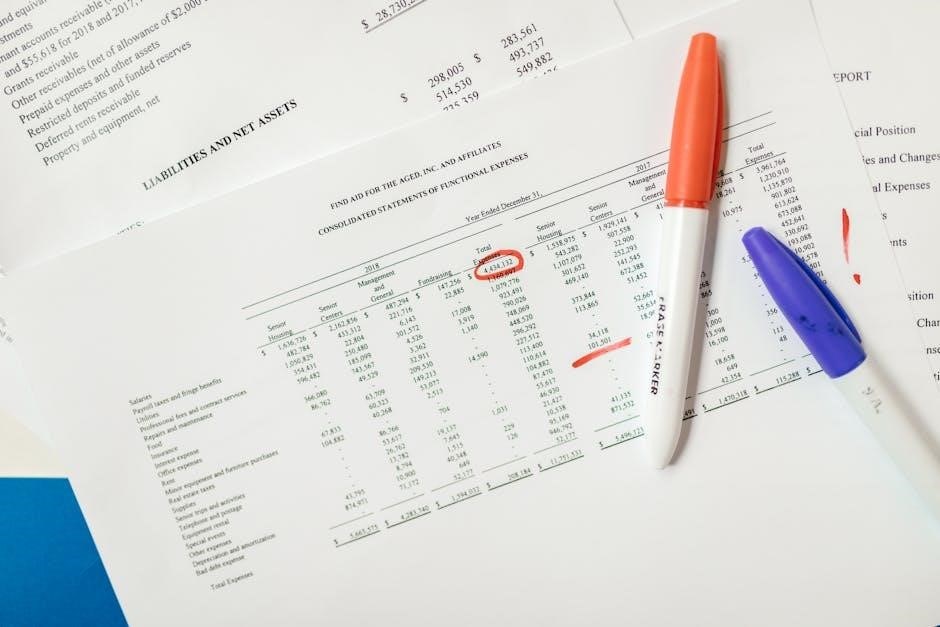Overview of Jane Austen’s Emma
Emma, by Jane Austen, follows the story of Emma Woodhouse, a young woman who navigates love, social class, and self-discovery in 19th-century England, showcasing Austen’s timeless insight into human nature.
Emma, written by Jane Austen, is a novel of manners that explores themes of love, social class, and self-discovery in 19th-century England. The story revolves around Emma Woodhouse, a young, wealthy, and somewhat spoiled woman who fancies herself a matchmaker. Her well-meaning but misguided attempts to arrange marriages for her friends often lead to misunderstandings and complications. Through Emma’s journey, Austen examines societal norms, personal growth, and the dangers of misjudging others. The novel is celebrated for its witty dialogue, nuanced characters, and insightful commentary on the social hierarchy of the time.
Significance of the Novel in Literary History
Jane Austen’s Emma holds a pivotal place in literary history as a seminal work of English fiction. Published in 1816, it refined the novel of manners, offering a nuanced exploration of social class, gender roles, and personal growth. Austen’s masterful use of irony, psychological depth, and realistic dialogue set a new standard for character-driven narratives. Emma influenced countless authors and remains a cornerstone of literary studies, celebrated for its timeless themes and its ability to reflect the complexities of human nature. Its enduring relevance underscores Austen’s lasting impact on world literature.
Purpose of the Summary
This summary provides a concise overview of Jane Austen’s Emma, capturing its core themes, character development, and plot intricacies. It serves as a valuable resource for readers seeking to understand the novel’s essence without delving into the full text. By highlighting Emma’s journey from self-deception to growth, the summary underscores the novel’s exploration of social class, love, and personal transformation. It also emphasizes Austen’s literary techniques, such as irony and dialogue, which contribute to the novel’s enduring appeal. This summary is particularly useful for students, educators, and enthusiasts looking to grasp the key elements of Emma efficiently.

Plot Overview
Emma Woodhouse, a wealthy young woman, navigates matchmaking, social dynamics, and personal growth in 19th-century England, facing misunderstandings and self-discovery while influencing those around her.
Setting and Background
The novel is set in the fictional village of Highbury and its surrounding areas in 19th-century England during the Regency era. This setting provides a backdrop of rural tranquility and social hierarchy, where class distinctions and social status play significant roles. The close-knit community allows for intricate relationships and constant interaction among characters, fostering gossip and misunderstandings. The setting reflects the limited opportunities and societal expectations for women during this period, particularly influencing Emma’s matchmaking endeavors and personal growth. The quiet, provincial life of Highbury contrasts with the bustling urban centers, emphasizing the insular world in which the story unfolds.
Emma Woodhouse is a young, handsome, clever, and wealthy woman living in the early 19th century. She resides in Hartfield, her family estate, and enjoys a life of comfort and privilege. Emma is described as having a happy disposition and a strong will, though her confidence often leads to misguided matchmaking attempts. Her intentions are good, but her lack of self-awareness and tendency to judge others based on appearances frequently result in misunderstandings. Emma’s character is both captivating and flawed, making her one of Austen’s most memorable protagonists. Her journey toward self-discovery drives the novel’s narrative.
Emma’s Matchmaking Adventures
Emma’s matchmaking adventures are central to the novel, driven by her desire to interfere in the lives of those around her. With good intentions but flawed judgment, she attempts to pair her friend Harriet Smith with Reverend Elton, unaware of his true intentions. Her meddling leads to misunderstandings and complications, particularly when her efforts misinterpret the feelings of others. Emma’s matchmaking highlights her naivety and overconfidence, ultimately revealing the dangers of presuming to control others’ destinies. These adventures serve as a catalyst for her personal growth and understanding of her own emotions.
Key Plot Twists and Turns
Emma’s journey is marked by significant plot twists, including the revelation of Frank Churchill’s secret engagement to Jane Fairfax, which upends Emma’s matchmaking schemes. Additionally, Mr. Elton’s rejection of Harriet Smith in favor of Emma herself shocks the community, exposing Emma’s misjudgments. A pivotal moment occurs when Emma insults Miss Bates at the picnic, leading to a confrontation with Mr. Knightley, who criticizes her behavior. These twists highlight Emma’s growth as she confronts her errors and ultimately realizes her true feelings for Mr. Knightley, culminating in a resolution that brings harmony to the characters’ lives.

Major Characters
Emma Woodhouse, a handsome, clever, and rich young woman, is the protagonist. Mr. Knightley serves as her mentor and voice of reason. Frank Churchill and Jane Fairfax’s secretive engagement adds complexity, while characters like Harriet Smith and Miss Bates enrich the narrative with their distinct roles and personalities.
Emma Woodhouse: The Protagonist
Emma Woodhouse, a handsome, clever, and rich young woman, is the protagonist of the novel. Living a life of comfort and privilege, Emma is determined to play matchmaker for her friends, though her efforts often lead to misunderstandings. Her confidence in her abilities sometimes blinds her to the realities of others’ feelings, leading to complications. Despite her flaws, Emma’s journey is one of self-discovery, as she learns from her mistakes and grows into a more empathetic and sensible individual. Her character embodies both the charm and the pitfalls of youthful arrogance and societal influence.
Mr. Knightley: The Voice of Reason
Mr. Knightley, a mature and wise gentleman, serves as Emma’s mentor and moral guide. As her brother-in-law and a close family friend, he offers rational advice, countering Emma’s impulsive matchmaking attempts. His calm demeanor and strong moral principles make him a stabilizing influence in Emma’s life. Knightley’s patience and understanding help Emma navigate her mistakes, while his subtle criticism encourages her to reflect on her actions. Their relationship evolves from a platonic bond to a deeper romantic connection, highlighting Knightley’s enduring respect and affection for Emma despite her flaws.
Frank Churchill: The Charismatic Figure
Frank Churchill, a charming and lively young man, brings energy and enthusiasm to Highbury. Raised by his wealthy aunt and uncle, he adopts their surname and enjoys a life of leisure, indulging in music and dance. Frank’s charisma often overshadows his less responsible nature, making him a complex character. His relationship with Jane Fairfax is central to the plot, as his secretive engagement and flirtatious behavior cause misunderstandings. While not entirely villainous, Frank’s carefree attitude and lack of transparency contribute to the novel’s twists, showcasing his dual nature as both captivating and flawed.
Jane Fairfax: The Reserved Young Woman
Jane Fairfax, an orphan, resides with her aunt, Miss Bates, and grandmother, Mrs. Bates, in Highbury. Her reserved nature and polished manners make her an enigma. Despite her talent for music and refined education, Jane’s quiet demeanor often leads to misunderstandings. Her secret engagement with Frank Churchill adds complexity to her character, as she navigates societal expectations and personal desires. Jane’s independence and resilience highlight her strength, even as she faces challenges in a society governed by class and marriage norms, making her a poignant figure in Austen’s exploration of women’s roles.
Other Notable Characters
Miss Bates, a kind-hearted and talkative spinster, brings warmth and humor to Highbury. Mr. Elton, an ambitious young clergyman, seeks a advantageous marriage, revealing his class-conscious nature. Emma’s father, Mr. Woodhouse, is a hypochondriac who dotes on his daughter, often hindering her growth. Harriet Smith, a young, impressionable woman, becomes Emma’s protégée, though her innocence and naivety make her a pawn in Emma’s matchmaking schemes. These characters enrich the novel, showcasing Austen’s ability to craft diverse personalities that drive the story’s social and emotional dynamics.

Themes and Motifs
Emma explores themes of social class, love, self-discovery, and appearances vs; reality, offering insights into early 19th-century society through Austen’s witty and nuanced portrayal.
Theme of Social Class
Jane Austen’s Emma intricately explores the theme of social class, highlighting the rigid hierarchy of early 19th-century England. Emma Woodhouse, as a member of the wealthy elite, embodies the privileges and pitfalls of her position. The novel critiques the social stratification through characters like the Bateses, who occupy a lower rung, and Frank Churchill, whose adoption of a higher status reflects societal aspirations. Austen’s portrayal of class influences relationships, opportunities, and individual identities, offering a nuanced commentary on the limitations and hypocrisies of the era’s social structure.
Love and Marriage in the Regency Era
Jane Austen’s Emma delves into the complexities of love and marriage during the Regency era, where societal expectations often overshadow personal desires. The novel portrays marriage as a union influenced by social standing, family connections, and economic stability. Characters like Frank Churchill and Jane Fairfax navigate secret engagements and societal pressures, while Emma’s matchmaking endeavors reveal the risks of misjudging others’ emotions. Through these narratives, Austen critiques the era’s rigid matrimonial norms, emphasizing the tension between romantic ideals and practical realities. Love, in Austen’s portrayal, is both a source of fulfillment and a potential trap shaped by societal constraints.
Self-Discovery and Personal Growth
Emma Woodhouse’s journey in Jane Austen’s novel is marked by significant self-discovery and personal growth. Initially, Emma is portrayed as spoiled, overconfident, and meddling, often misjudging others due to her own biases. Through her matchmaking attempts and the criticism she receives, particularly from Mr. Knightley, Emma begins to recognize her flaws and the harm caused by her interference. Her experiences lead to a deeper understanding of herself and others, fostering humility and better judgment; Ultimately, Emma evolves from a naive, self-assured young woman to one who embraces responsibility and genuine emotional awareness, highlighting Austen’s exploration of personal transformation and maturity.
Appearances vs. Reality
Jane Austen’s Emma explores the theme of appearances vs. reality through characters whose true natures are often obscured by societal expectations or personal deceptions. Frank Churchill, for instance, appears charming but hides his secret engagement with Jane Fairfax. Similarly, Emma’s misjudgments about Harriet Smith and Mr. Elton reveal how appearances can mislead. Mr. Knightley, with his honest and insightful nature, represents the voice of reality, challenging Emma’s illusions. This theme underscores the novel’s critique of social superficiality and the importance of discerning true character beneath outward appearances.

Symbols and Symbolism
Highbury symbolizes the confined, hierarchical society Emma inhabits, while her matchmaking represents her journey of self-discovery and societal critique, reflecting Austen’s exploration of class and identity.
The Role of Highbury as a Symbol
Highbury serves as a microcosm of the societal world Emma inhabits, symbolizing the confined, hierarchical community governed by strict social norms. Its setting reflects Emma’s limited perspective and her attempts to navigate the complexities of relationships within a structured environment. The town’s insularity mirrors the narrow social circle and class distinctions that drive the novel’s conflicts. Through Highbury, Austen critiques the social hierarchy of her time, using it as a backdrop to explore themes of class, status, and personal growth, ultimately highlighting Emma’s journey toward self-awareness and societal understanding.
Symbolism in Emma’s Matchmaking
Emma’s matchmaking endeavors symbolize her desire for control and order in her life, reflecting her flawed understanding of love and social dynamics. Her attempts to manipulate relationships, such as Harriet Smith’s, highlight her naivety and overconfidence, serving as a metaphor for the dangers of meddling in others’ lives. Through her failed efforts, Austen critiques societal pressures on women to marry for status, while also illustrating Emma’s gradual self-awareness and growth. The matchmaking further symbolizes the tension between appearances and reality, as Emma’s perceptions often clash with the true nature of those around her.
Other Symbolic Elements in the Novel
Beyond matchmaking, the novel employs symbols like the piano, representing Jane Fairfax’s hidden emotions, and the Highway, symbolizing unexpected encounters and societal intersections. The ball at the Crown Inn embodies social hierarchy and blurred boundaries, while Frank Churchill’s letters reveal hidden truths and deception. These elements underscore themes of class, identity, and the complexities of human relationships, enriching the narrative with deeper layers of meaning and reflection on the societal norms of Austen’s time.

Social Commentary
Jane Austen’s Emma offers a sharp critique of Regency-era social hierarchy, exploring class distinctions, women’s limited roles, and the hypocrisies of a society governed by status and etiquette.
Critique of Social Hierarchy
Jane Austen’s Emma critiques the rigid social hierarchy of the Regency era, highlighting class distinctions and their impact on relationships. Through Emma’s matchmaking attempts, Austen exposes the biases and snobbery prevalent among the upper class, particularly in Emma’s treatment of Jane Fairfax and Robert Martin. The novel illustrates how social status often overshadows personal merit, as seen in the contrast between characters like Mr. Knightley and Frank Churchill. While Austen doesn’t dismantle the system, she reveals its flaws, emphasizing the limitations it imposes on individuals, especially women, and the societal pressures that shape their choices and opportunities.
Women’s Roles in Society
Jane Austen’s Emma examines the limited roles of women in Regency-era society, emphasizing their dependence on marriage for social and financial security. Emma Woodhouse, though wealthy and independent, embodies the societal constraints placed on women, as her influence is largely confined to matchmaking. The novel highlights the lack of career opportunities for women, as seen in Jane Fairfax’s potential fate as a governess. Austen critiques the societal norms that restrict women’s autonomy, illustrating how their lives are shaped by marriage, family, and social expectations rather than personal ambition or intellectual pursuits.
Class and Status in the Novel
Jane Austen’s Emma intricately explores the significance of class and status in Regency-era England. The novel portrays a society where social standing dictates opportunities and relationships, with characters like Emma Woodhouse embodying privilege and influence. Austen highlights the rigid class distinctions, as seen in the contrast between the wealthy Woodhouses and the less affluent Bates family. The novel critiques the social hierarchy, revealing how class affects marriage prospects, personal freedom, and respectability. Through characters like Jane Fairfax and Mr. Knightley, Austen illustrates the tensions and complexities of navigating a society governed by status and material security.

Literary Style and Technique
Jane Austen’s Emma showcases her mastery of narrative structure, employing irony and free indirect discourse to delve into characters’ psyches, while sharp dialogues reveal societal nuances.
Austen’s Use of Irony
Jane Austen employs irony masterfully in Emma, using dramatic and situational irony to highlight the disparity between characters’ perceptions and reality. Emma’s misguided matchmaking attempts, driven by her flawed assumptions, serve as a prime example of Austen’s ironic narrative. The novel’s irony underscores societal hypocrisies and the limitations of human understanding, while also adding layers of humor and depth to the storytelling. Through irony, Austen critiques the social conventions of her time, offering a nuanced exploration of human folly and the complexities of relationships.
Narrative Structure and Point of View
Jane Austen’s Emma is narrated in the third-person limited point of view, primarily focusing on Emma Woodhouse’s thoughts and feelings. This narrative structure allows readers to experience Emma’s growth and self-awareness firsthand. The novel’s episodic structure, divided into chapters, highlights key events and character interactions, providing a detailed exploration of societal dynamics and personal development. Austen’s choice of perspective enhances the novel’s depth, offering insight into Emma’s flaws and eventual transformation, while maintaining a balanced critique of the social world she inhabits.
Dialogue and Character Development
Jane Austen’s Emma excels in using dialogue to reveal character traits and advance the plot. Conversations between Emma and Mr. Knightley highlight her growth from self-deception to self-awareness. The dialogue exposes Emma’s wit, vanity, and eventual humility, while also showcasing Mr. Knightley’s patience and wisdom. Secondary characters, like Miss Bates and Frank Churchill, are skillfully portrayed through their speech, adding depth to the narrative. Austen’s mastery of dialogue ensures that each character’s voice reflects their social status, personality, and motivations, enriching the novel’s exploration of human nature and societal dynamics.

Reception and Legacy
Jane Austen’s Emma has endured as a timeless classic, celebrated for its nuanced portrayal of society and human nature, inspiring countless adaptations and remaining a beloved literary masterpiece.
Initial Reception of the Novel
Published anonymously in 1815, Emma received mixed reviews upon its release. The first edition sold out quickly, indicating strong public interest. Critics praised its moral lessons and nuanced character portrayals, while others found it dull or lacking in grandeur. The novel’s subtle humor and commentary on society were appreciated by some, though its focus on domestic life was criticized by others. Despite initial mixed opinions, Emma gradually gained recognition as a masterpiece of English literature, celebrated for its depth and insight into human nature.
Modern Interpretations and Relevance
Today, Emma remains a timeless classic, resonating with modern audiences through its exploration of universal themes like social class, gender roles, and personal growth. Its nuanced portrayal of human behavior continues to inspire adaptations in film, television, and literature. Modern readers appreciate Austen’s witty dialogue and the novel’s psychological depth, while scholars analyze its commentary on societal structures. The novel’s relevance endures as it reflects contemporary discussions on identity, relationships, and self-awareness, proving Austen’s work transcends time and cultural boundaries.
Cultural Impact of Emma
Jane Austen’s Emma has left an indelible mark on literature and popular culture. Its timeless themes and relatable characters have inspired countless adaptations, including films, television series, and modern retellings. The novel’s exploration of social class, love, and self-discovery continues to resonate, making it a staple in academic and casual reading. Emma’s character, with her flaws and growth, has become a cultural icon, influencing portrayals of strong, complex female protagonists in media. The novel’s enduring appeal highlights Austen’s ability to craft stories that transcend time, reflecting and shaping societal attitudes toward relationships and identity.

Adaptations and Interpretations
Emma has been adapted into numerous films, TV series, and stage productions, each offering unique interpretations of Austen’s timeless story, ensuring its enduring relevance across generations.
Movie and Television Adaptations
Emma has been adapted into numerous films and TV series, each offering a fresh interpretation of Austen’s novel. The 1996 film starring Gwyneth Paltrow and the 2020 adaptation featuring Anya Taylor-Joy are notable examples. These productions bring Emma’s matchmaking misadventures and personal growth to life, capturing the essence of Austen’s wit and social commentary. Each adaptation highlights the timeless appeal of the novel, blending period authenticity with modern sensibilities. They remain popular, introducing Emma’s story to new audiences while delighting long-time fans with their faithful yet creative interpretations of the classic tale.
Stage Productions and Other Media
Emma has been adapted into various stage productions, including plays and musicals, which bring Austen’s characters and dialogue to life. A notable example is the 2017 stage production created by Leah Heim and Julia Robben, showcasing the novel’s enduring appeal. Additionally, Emma has been transformed into radio dramatizations, audio books, and even graphic novels, expanding its reach beyond traditional formats. These adaptations highlight the versatility of Austen’s work, allowing audiences to engage with Emma’s story in diverse and innovative ways, further cementing its place in literary and cultural history.
Modern Retellings and Inspired Works
Emma has inspired numerous modern retellings, such as the 2020 film adaptation starring Anya Taylor-Joy, which reimagines Austen’s classic in a contemporary setting. Additionally, works like “The Emma Project” by Sonali Dev offer fresh perspectives, blending Austen’s themes with modern cultural contexts. These reinterpretations highlight Emma’s timeless appeal, allowing new audiences to connect with its exploration of social dynamics and personal growth. By reimagining the novel in diverse settings, these works demonstrate the enduring relevance of Austen’s insights into human nature and society.

Study Guides and Resources
Various study guides and online resources, such as Resoomer and Scribbr, offer summaries and analyses of Emma, aiding readers in understanding the novel’s themes and characters effectively.
Available Study Guides for Emma
Various online platforms offer comprehensive study guides for Emma, providing summaries, character analyses, and thematic insights. Tools like Resoomer and Scribbr enable quick summarization of texts, while websites such as Gradesaver offer detailed chapter breakdowns and academic essays. Additionally, video summaries and educational plugins assist students in understanding the novel’s complexities. These resources cater to diverse learning needs, making it easier for readers to grasp Austen’s nuanced exploration of social class, love, and personal growth in Emma. They serve as invaluable aids for both casual readers and scholars alike.
Online Resources and Summaries
Online resources provide accessible summaries and analyses of Emma, aiding readers in understanding its complexities. Tools like Resoomer and Scribbr offer AI-powered summarization, while Noiz enables clear, concise summaries without registration. Video summaries and plugins, such as Course Assistant, simplify comprehension for visual learners. Additionally, websites like Gradesaver and BroadwayWorld offer detailed study guides, chapter breakdowns, and essays. These resources cater to diverse learning styles, making Austen’s exploration of social class, love, and personal growth in Emma more approachable for both students and enthusiasts.
Academic Analysis and Essays
Academic platforms like Gradesaver and Executive Book Summaries provide in-depth analyses of Emma, offering essays and critical perspectives. These resources explore themes such as social class, love, and personal growth, while also examining Austen’s narrative techniques. Scholars and students can access detailed character studies, thematic breakdowns, and historical context, enhancing their understanding of the novel. These essays often highlight Austen’s irony and the societal critiques embedded in her work, making them invaluable for academic exploration and research into Emma’s enduring relevance.
Emma’s journey of self-discovery and matchmaking misadventures culminates in a harmonious resolution, highlighting Austen’s exploration of love, social class, and personal growth, leaving a lasting literary legacy.
Final Thoughts on Emma
Jane Austen’s Emma remains a timeless exploration of personal growth, love, and societal norms. Emma Woodhouse’s journey from self-deception to self-awareness offers profound insights into human nature. The novel’s intricate portrayal of relationships and social class continues to resonate with modern readers; Austen’s critique of societal hierarchies and the limited roles of women in the Regency era adds depth to the narrative. Through its enduring legacy, Emma invites readers to reflect on their own biases and aspirations, solidifying its place as a cornerstone of English literature.
Importance of Reading the Novel
Reading Emma offers profound insights into the human condition, exploring themes of social class, love, and self-discovery. Its timeless critique of societal norms and relationships remains relevant today, providing a mirror to both historical and contemporary life. Austen’s masterful use of irony and narrative structure enriches the reading experience, while Emma’s personal growth fosters empathy and self-awareness. The novel’s enduring legacy as a cornerstone of English literature makes it essential for understanding both the past and our own societal dynamics, ensuring its continued relevance and enduring value for modern readers.
Encouragement for Further Exploration
Exploring Emma further offers a deeper understanding of its intricate characters, themes, and historical context. Readers are encouraged to delve into the full novel to experience Austen’s nuanced portrayal of societal norms and personal growth. Analyzing Emma’s evolution from a meddling matchmaker to a self-aware individual provides valuable insights into human behavior. Additionally, examining the novel’s adaptations and interpretations can enrich one’s appreciation of its timeless appeal. Engaging with study guides and academic analyses can further illuminate the novel’s layers, making it a rewarding journey for both casual readers and scholars alike.

